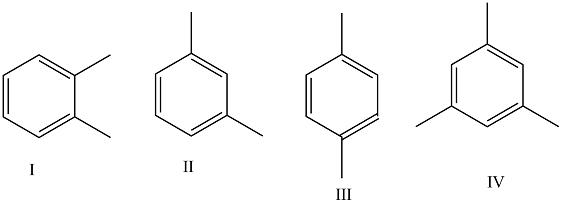
Which of the given structures corresponds to p-xylene?

A.I
B.II
C.III
D.IV

Answer
544.8k+ views
Hint:As we are aware that the p- stands for para-, P-xylene is a xylene with methyl groups occupying the diametrically opposite substituent positions, i.e. positions 1 and 4. The chemical formula of p-xylene is C6H4(CH3)2.
Complete answer:
p-xylene or para-xylene is an aromatic hydrocarbon. It is one of the three isomers of dimethylbenzene which is known collectively as xylenes. The p- stands for para-, which indicates that the two methyl groups are present in p-xylene and occupy the diametrically opposite substituent positions i.e. 1 and 4. It is in the positions of the two methyl groups, their arene substitution pattern, that it differs from the other isomers, o-xylene and m-xylene. All have the same chemical formula \[{C_6}{H_4}{\left( {C{H_3}} \right)_2}\]
The structure I use corresponds to o-xylene. O-xylene is 1,2-dimethylBenzene.
The structure II corresponds to m-xylene (1,3-dimethylBenzene).
The structure III corresponds to p-xylene (1,4-dimethylbenzene).
The structure IV corresponds to mesitylene (1,3,5-trimethylbenzene).
Therefore, the correct answer is option (C).
Note:
P-xylene is a colorless watery liquid with a sweet odor. It is less dense than water and it is also insoluble in water but very soluble in ethanol and diethyl ether. It is irritating vapor. Its freezing point is 55.8°F and its Boiling point is 281.03 °F and is highly flammable. The odor threshold of p-xylene is 0.62 parts per million (ppm). The commercial or mixed xylene usually contains about 40-65% m-xylene and up to 20% each of o-xylene and p-xylene and ethylbenzene. Xylenes are released into the atmosphere as fugitive emissions from industrial sources, from the auto exhaust, and through volatilization from their use as solvents. The short-term inhalation exposure to mixed xylenes in humans can cause irritation of the eyes, nose, and throat, gastrointestinal effects, eye irritation, and neurological effects.
Complete answer:
p-xylene or para-xylene is an aromatic hydrocarbon. It is one of the three isomers of dimethylbenzene which is known collectively as xylenes. The p- stands for para-, which indicates that the two methyl groups are present in p-xylene and occupy the diametrically opposite substituent positions i.e. 1 and 4. It is in the positions of the two methyl groups, their arene substitution pattern, that it differs from the other isomers, o-xylene and m-xylene. All have the same chemical formula \[{C_6}{H_4}{\left( {C{H_3}} \right)_2}\]
The structure I use corresponds to o-xylene. O-xylene is 1,2-dimethylBenzene.
The structure II corresponds to m-xylene (1,3-dimethylBenzene).
The structure III corresponds to p-xylene (1,4-dimethylbenzene).
The structure IV corresponds to mesitylene (1,3,5-trimethylbenzene).
Therefore, the correct answer is option (C).
Note:
P-xylene is a colorless watery liquid with a sweet odor. It is less dense than water and it is also insoluble in water but very soluble in ethanol and diethyl ether. It is irritating vapor. Its freezing point is 55.8°F and its Boiling point is 281.03 °F and is highly flammable. The odor threshold of p-xylene is 0.62 parts per million (ppm). The commercial or mixed xylene usually contains about 40-65% m-xylene and up to 20% each of o-xylene and p-xylene and ethylbenzene. Xylenes are released into the atmosphere as fugitive emissions from industrial sources, from the auto exhaust, and through volatilization from their use as solvents. The short-term inhalation exposure to mixed xylenes in humans can cause irritation of the eyes, nose, and throat, gastrointestinal effects, eye irritation, and neurological effects.
Recently Updated Pages
Master Class 12 Business Studies: Engaging Questions & Answers for Success

Master Class 12 Economics: Engaging Questions & Answers for Success

Master Class 12 English: Engaging Questions & Answers for Success

Master Class 12 Maths: Engaging Questions & Answers for Success

Master Class 12 Social Science: Engaging Questions & Answers for Success

Master Class 12 Chemistry: Engaging Questions & Answers for Success

Trending doubts
What is meant by exothermic and endothermic reactions class 11 chemistry CBSE

Which animal has three hearts class 11 biology CBSE

10 examples of friction in our daily life

One Metric ton is equal to kg A 10000 B 1000 C 100 class 11 physics CBSE

1 Quintal is equal to a 110 kg b 10 kg c 100kg d 1000 class 11 physics CBSE

Difference Between Prokaryotic Cells and Eukaryotic Cells




